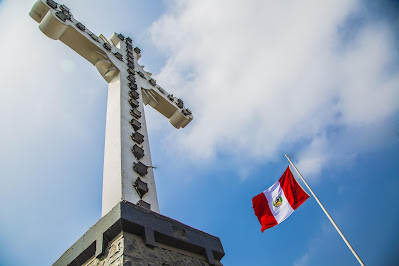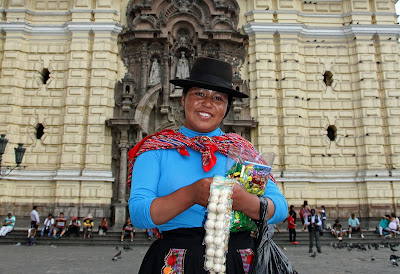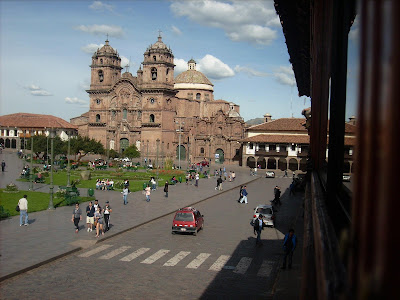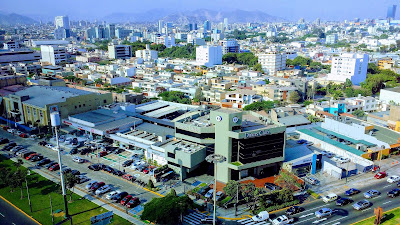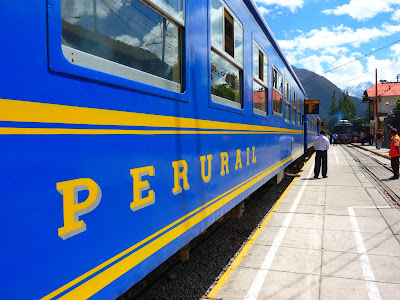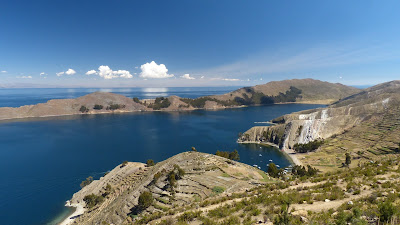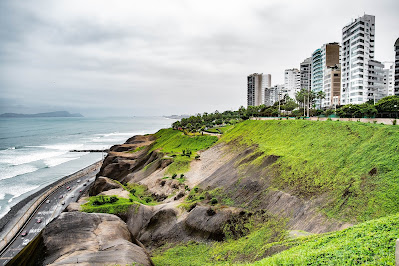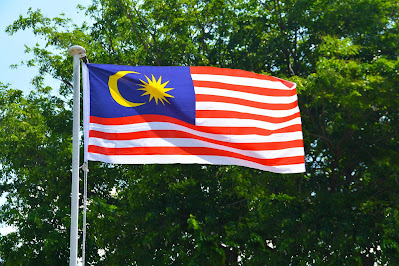All About Peru - Peru Tourism, Facts about Peru
Geography
Area: 1.28 million sq. km. (496,225 sq. mi.). Peru is the third-largest country in South America and is approximately three times the size of California.
Major cities: Lima (capital), Arequipa, Chiclayo, Cuzco, Huancayo, Ica, Trujillo, Ayacucho, Piura, Iquitos, and Chimbote.
Terrain: Western arid coastal plains, central rugged Andean mountains, and eastern lowlands with tropical forests that are part of the Amazon basin.
Climate: Arid and mild in coastal area, temperate to frigid in the Andes, and warm and humid in the jungle lowlands.
People
Nationality: Peruvian.
Ethnic groups: Indigenous (45%); mixed background ("mestizo") (37%); European (15%); African, Japanese, Chinese, and other (3%).
Population (2009): 29.11 million. Approximately 30% of the population lives in the Lima/Callao metropolitan area.
Annual population growth rate (2009): 1.11%.
Religions: Roman Catholic (81%), other (10%).
Languages: Spanish is the principal language. Quechua, Aymara and other indigenous languages also have official status.
Education: Years compulsory--11. Attendance--ages 6-11, 92%; ages 12-16, 66%. Literacy--96% in urban areas, 80% in rural areas.
Health: Infant mortality rate (2006)--29.96 per 1,000. Life expectancy (2007)--68.33 years male; 72.04 years female.
Unemployment in Lima (2009): 8.4%; underemployment (2009): 44.66%.
Government
Type: Constitutional republic.
Independence: July 28, 1821.
Constitution: December 31, 1993.
Branches: Executive--president, two vice presidents, and a Council of Ministers led by a president of the Council of Ministers (prime minister). Legislative--unicameral Congress. Judicial--four-tier court structure consisting of Supreme Court and lower courts.
Administrative divisions: 25 regions (sometimes called departments) subdivided into 195 provinces and 1,834 districts.
Political parties: Alianza Popular Revolucionaria Americana (APRA), Popular Christian Party PPC), Peruvian Nationalist Party (PNP), Peru Posible (PP), Popular Action (AP), National Solidarity (SN), Union for Peru (UPP), Somos Peru (SP), National Restoration (RN), and Force 2011.
Suffrage: Universal and mandatory for citizens 18 to 70.
Economy
GDP (2009): $127.22 billion.
Annual growth rate: 9.8% (2008); 0.9% (2009).
Per capita GDP (2009): $4,365.
Natural resources: Copper, gold, silver, zinc, lead, iron ore, fish, petroleum, natural gas, and forestry.
Manufacturing (2009): 14.33% of GDP. Types--food and beverages, textiles and apparel, nonferrous and precious metals, nonmetallic minerals, petroleum refining, paper, chemicals, iron and steel, fishmeal.
Agriculture (2009): 7.8% of GDP. Products--coffee, cotton, asparagus, paprika, artichokes, sugarcane, potatoes, rice, banana, maize, poultry, milk, others.
Other sectors, by percentage of GDP (2009): Services (54%), mining (5.7%), construction (6.2%), fisheries (0.44%).
Trade (2009 Government of Peru customs statistics): Exports--$26.66 billion: gold, copper, fishmeal, petroleum, zinc, textiles, apparel, asparagus, coffee, others. Major markets--U.S. (17%), China (15.3%), Switzerland (14.9%), Canada (8.7%), Japan (5.1%), Germany (3.9%), South Korea (2.8%), Chile (2.8%). Imports--$20.4 billion: petroleum and petroleum products, vehicles, plastics, steel, telephones, wheat, soy oil and soy products, commercial machinery, processed food. Major suppliers--U.S. (19.7%), China (15%), Brazil (7.7%), Ecuador (4.9%), Chile (4.6%), Colombia (4.4%), Japan (4.1%).
PEOPLE
Peru is the fifth most populous country in Latin America (after Brazil, Mexico, Colombia, and Argentina). Twenty-one cities have a population of 100,000 or more. Rural migration increased the urban population from 35.4% of the total population in 1940 to an estimated 74.6% as of 2005.
Most Peruvians are either Spanish-speaking mestizos--a term that usually refers to a mixture of indigenous and European/Caucasian--or Amerindians, largely Quechua-speaking indigenous people. Peruvians of European descent make up about 15% of the population. There also are small numbers of persons of African, Japanese, and Chinese ancestry. Socioeconomic and cultural indicators are increasingly important as identifiers. For example, Peruvians of Amerindian descent who have adopted aspects of Hispanic culture also are considered mestizo. With economic development, access to education, intermarriage, and large-scale migration from rural to urban areas, a more homogeneous national culture is developing, mainly along the relatively more prosperous coast. Peru's distinct geographical regions are mirrored in a socioeconomic divide between the coast's mestizo-Hispanic culture and the more diverse, traditional Andean cultures of the mountains and highlands and Amazon indigenous communities east of the Andes.
HISTORY, GOVERNMENT, AND POLITICAL CONDITIONS
The Inca Empire and Spanish Conquest when the Spanish landed in 1531, Peru's territory was the nucleus of the highly developed Inca civilization. Centered at Cuzco, the Incan Empire extended over a vast region from northern Ecuador to central Chile. In search of Inca wealth, the Spanish conqueror Francisco Pizarro, who arrived in the territory after the Incas had fought a debilitating civil *, conquered the weakened people. The Spanish captured the Incan capital at Cuzco by 1533, and consolidated their control by 1542. Gold and silver from the Andes enriched the conquerors, and Peru became the principal source of Spanish wealth and power in South America.
Pizarro founded Lima in 1535. The viceroyalty established at Lima in 1542 initially had jurisdiction over all of the Spanish colonies in South America. By the time of the *s of independence (1820-24), Lima had become one of the most distinguished and aristocratic colonial capitals and the chief Spanish stronghold in the Americas (along with Mexico City).
Independence
Jose de San Martin of Argentina and Simon Bolivar of Venezuela led Peru's independence struggle. San Martin proclaimed Peruvian independence from Spain on July 28, 1821. Emancipation was completed in December 1824, when Venezuelan Marshall Antonio Jose de Sucre defeated a Spanish army at Ayacucho, ending Spain's rule in South America. Spain subsequently made futile attempts to regain its former colonies, but in 1879 it finally recognized Peru's independence.
After independence, Peru and its neighbors engaged in intermittent territorial disputes. Chile's victory over Peru and Bolivia in the * of the Pacific (1879-83) resulted in a territorial settlement in which Peru ceded the department of Tarapaca and the provinces of Tacna and Arica to Chile. In 1929, Chile returned Tacna to Peru. Following a clash between Peru and Ecuador in 1941, the Rio Protocol--of which the United States is one of four guarantors (along with Argentina, Brazil and Chile)--sought to establish the boundary between the two countries. Continuing boundary disagreements led to brief armed conflicts in early 1981 and early 1995, but in 1998 the governments of Peru and Ecuador signed an historic peace treaty and demarcated the border. In late 1999, the governments of Peru and Chile likewise implemented the last outstanding article of their 1929 border agreement. Peru and Chile still dispute the maritime boundary.
Contemporary History
Military Rule and Return to Democracy (1968-1980)
The military has been prominent in Peruvian history. Coups have repeatedly interrupted civilian constitutional government. The most recent period of military rule (1968-80) began when General Juan Velasco Alvarado overthrew elected President Fernando Belaunde Terry of the Popular Action Party (AP). As part of what has been called the "first phase" of the military government's nationalist program, Velasco undertook an extensive agrarian reform program and nationalized the fishmeal industry, some petroleum and mining companies, and several banks.
Because of Velasco's economic mismanagement and deteriorating health, he was replaced in 1975 by General Francisco Morales Bermudez. Morales Bermudez tempered the authoritarian abuses of the Velasco administration and began the task of restoring the country's economy. Morales Bermudez presided over the return to civilian government under a new constitution, and in the May 1980 elections President Belaunde Terry was returned to office by an impressive plurality.
Instability in the 1980s
Nagging economic problems left over from the military government persisted, worsened by an occurrence of the "El Nino" weather phenomenon in 1982-83, which caused widespread flooding in some parts of the country, severe droughts in others, and decimated the fishing industry. The fall in international commodity prices to their lowest levels since the Great Depression combined with the natural disasters to decrease production, depress wages, exacerbate unemployment, and spur inflation. Bloated state-owned companies compounded the deteriorating fiscal situation. The ensuing economic collapse was reflected in worsening living conditions for Peru's poor and provided a breeding ground for social and political discontent. The emergence of two terrorist groups--Sendero Luminoso (Shining Path) in rural areas in 1980, followed shortly thereafter by the Tupac Amaru Revolutionary Movement (MRTA) in Lima--sent the country further into chaos. The terrorists were financed in part from alliances with narcotraffickers, who had established a stronghold in the Peruvian Andes during this period. Peru and Bolivia became the largest coca producers in the world, accounting for roughly four-fifths of the production in South America.
Amid inflation, economic hardship, and terrorism, Alan Garcia Perez of the American Popular Revolutionary Alliance (APRA) won the presidential election in 1985. The transfer of the presidency from Belaunde to Garcia on July 28, 1985, was Peru's first transfer of power from one democratically elected leader to another in 40 years. The Garcia administration’s economic mismanagement led to hyperinflation from 1988 to 1990 and concerned about the economy, the increasing terrorist threat from Sendero Luminoso, and allegations of official corruption, in 1990 voters chose as President a relatively unknown mathematician-turned-politician, Alberto Fujimori.
The Fujimori Decade (1990-2000)
Although he ran on a populist platform, promising not to implement the macroeconomic shock package proposed by his opponent, novelist Mario Vargas Llosa, the severe economic situation forced Fujimori to carry out radical changes. He immediately implemented drastic economic policies to tackle inflation (which dropped from 7,650% in 1990 to 139% in 1991), but encountered opposition to further economic reforms, including dealing with the growing insurgency. On April 5, 1992, Fujimori dissolved the Congress in an "auto-coup," revamped the constitution, and intervened in the Supreme Court. Later, pressured by the international community, Fujimori called new congressional elections. With a large majority in Congress, Fujimori proceeded to govern unimpeded. Large segments of the judiciary, the military and the media were co-opted by Fujimori's security advisor, Vladimiro Montesinos. The government unleashed a counterattack against the insurgency that resulted in numerous human rights abuses on both sides and eventually quashed the Shining Path and MRTA. During this period Fujimori introduced far-reaching legal and economic reforms, privatized most state-owned companies, removed investment barriers, and significantly improved public finances. In 1998, Fujimori reached a milestone peace accord with Ecuadorian President Jamil Mahuad related to the common border, ending decades of hostility between the two countries.
Fujimori's constitutionally questionable decision to seek a third term, and subsequent tainted electoral victory in June 2000, brought political and economic turmoil. A political bribery scandal that broke just weeks after he began his third term in July forced Fujimori to call new elections in which he would not run. Fujimori fled to Japan and resigned from office in November 2000. A caretaker government under Valentin Paniagua presided over new presidential and congressional elections in April 2001. In the presidential contest, Alejandro Toledo defeated Alan Garcia (who had returned to Peru that year after several years in France) in a runoff and took office on July 28, 2001.
The Toledo Administration (2001-2006)
The Toledo government consolidated Peru's return to democracy, a process that had begun under President Paniagua. Despite being a frequent target of political and media criticism, Toledo maintained strong commitments to freedom of the press. The government undertook initiatives to implement the recommendations of the Truth and Reconciliation Commission (TRC), which had been charged with studying the circumstances surrounding the human rights abuses and violations committed between 1980 and 2000. Criminal charges for corruption and human rights violations were brought against former President Fujimori. Fujimori was detained in Chile in November 2005 and extradited to face criminal charges in Peru in September 2007. On December 11, 2007, Fujimori was convicted of ordering an illegal search and seizure of documents and sentenced to 6 years in prison. In April 2009, Fujimori was convicted of human rights violations and sentenced to 25 years in prison. He was convicted in July and September 2009 on embezzlement and corruption charges, respectively, sentenced to 7.5 years, and ordered to pay $10 million in civil reparations.
Under President Toledo, Peru negotiated a trade promotion agreement (the PTPA) with the U.S. (later signed by President Garcia in 2007). Toledo also unveiled plans to construct a road connecting Brazil and Peru's isolated interior to the Pacific coast. Toledo's economic management--a continuation of Fujimori’s--led to an impressive economic boom in Peru that remains strong. Poverty reduction was uneven, however. Although poverty in some areas decreased to 15.8% during the Toledo administration, nationally it only decreased by 9.8% and nearly half (44.5%) of Peruvians were still living below the poverty line. In 2005 the government implemented "Juntos," a program to double the income of people living in extreme poverty (17.4% that year).
The Garcia Administration
On June 4, 2006, APRA candidate Alan Garcia Perez was elected to the presidency by 52.5% of the voters in his runoff with Ollanta Humala, who won the first round under the Union for Peru party banner, with the support of his Peruvian Nationalist Party. APRA also won 36 congressional seats and controls the largest voting bloc. After his disappointing presidential term from 1985 to 1990, Garcia returned to the presidency with the intention of turning around the perception of him that his first term had generated. During his second term, Garcia has overseen a robust macroeconomic performance, including strong GDP growth and declining poverty levels (39.3% of Peruvians were “poor” in 2007, 36.2% in 2008, and 34.8% in 2009). Since the onset of the international financial crisis in late 2008, Garcia’s low popularity has begun to recover. A violent clash between indigenous protesters and the police in the Amazon in June 2009, in which 10 protesters and 24 police officers died, prompted Garcia’s biggest political crisis to date, and his approval rating dropped to 20% (with 76% of Peruvians disapproving of him). His popularity has rebounded, and is now at about 30%. Internationally, Garcia has sought to reenergize Peru’s international relations and economic relations with the world and to showcase Peru's democratic and pro-free trade path as a model for the region. He successfully hosted two international summits in 2008, the European Union-Latin America and Caribbean summit and the Asia-Pacific Economic Cooperation (APEC) leaders’ summit, and the Organization of American States General Assembly in 2010. The U.S.-Peru Trade Promotion Agreement (PTPA) went into effect in February 2009. Peru has signed trade deals with Canada, Singapore, China, the European Union, and Korea and has begun trade negotiations with Japan and others.
Constitution and Political Institutions
The president is popularly elected for a 5-year term. A constitutional amendment passed in 2000 prevents immediate reelection, but allows unlimited nonconsecutive terms. The first and second vice presidents also are popularly elected but have no constitutional functions unless the president is unable to discharge his duties. The principal executive body is the Council of Ministers, comprised of 17 members following the creation in 2010 of a Ministry of Culture, and headed by a prime minister. The president appoints its members, who must be ratified by the Congress. All executive laws sent to Congress must be approved by the Council of Ministers.
The legislative branch consists of a unicameral Congress of 120 members. In addition to passing laws, Congress ratifies treaties, authorizes government loans, and approves the government budget.
The judicial branch of government is headed by a 16-member Supreme Court. The Constitutional Tribunal interprets the constitution on matters of individual rights. Superior courts in regional capitals review appeals from decisions by lower courts. Courts of first instance are located in provincial capitals and are divided into civil, penal, and special chambers. The judiciary has created several temporary specialized courts in an attempt to reduce the large backlog of cases pending final court action. In 1996 a human rights ombudsman's office was created.
Peru is divided into 25 regions that are still sometimes referred to as "departments." The regions are subdivided into provinces, which are composed of districts. High authorities at the regional and local levels are elected. The country’s decentralization program is designed to return some of the mining and hydrocarbons royalties (canon) to the regions so that infrastructure projects can take place.
ECONOMY
Peru's economic growth was strong over the 7 years up to 2008, averaging 6.8% a year, resulting from market-oriented economic reforms (which included measures to promote trade and attract investment) and privatizations in the 1990s. GDP grew 9.8% in 2008, 8.9% in 2007, 7.7% in 2006, and 6.8% in 2005. Economic expansion in recent years has been driven by construction, mining, private investment, exports, and domestic consumption. President Alan Garcia and his economic team have continued these policies. Peru's economy is well managed, and better tax collection and growth have been increasing revenues, with expenditures keeping pace. Private investment is rising and becoming more broad-based. Peru obtained investment grade status in 2008. The Garcia administration is pursuing decentralization initiatives, and is focused on bringing more small businesses into the formal economy.
Peru weathered the 2008 global financial crisis well and was one of the few Latin American countries that had a positive growth rate, although GDP grew just 0.9% in 2009 in the face of the world recession and lower commodity export prices. Inflation (annual average) receded to 2.9% in 2009 after jumping to 5.8% in 2008 due mostly to substantial global food and oil price increases; 3 consecutive years of fiscal surplus turned into a deficit of 11.9% of GDP. Thanks to pre-payments, public external debt in 2009 dropped to $20.6 billion or 16.2% of GDP (compared to 70.9% at the end of 1988), and foreign reserves were a record $33.2 billion.
Foreign Trade
Peru and the U.S. signed the U.S.-Peru Trade Promotion Agreement (PTPA) in April 2006 in Washington, DC. The PTPA was ratified by the Peruvian Congress in June 2006 and by the U.S. Congress in December 2007. The Peruvian Government passed several changes to its environmental and intellectual property laws in order to allow the PTPA to enter into force. The PTPA entered into force on February 1, 2009.
Peru’s exports reached $26.6 billion in 2009, partly as a result of lower mineral prices. Peru's major trading partners are the U.S., China, EU, Switzerland, Canada, and Japan. According to U.S. Government statistics, after 9 years of surpluses Peru registered a deficit in its trade with the United States of $371 million in 2008 and $696 million in 2009, exporting $4.2 billion and importing $4.9 billion in 2009. Peru’s exports include petroleum, gold, copper, apparel, tin, coffee, non-ferrous ores, asparagus, fishmeal, zinc, and textiles. Imports include machinery, petroleum products, electrical machinery, plastics, vehicles, steel, and cereals. Peru belongs to the Andean Community, the Asia-Pacific Economic Cooperation (APEC) forum, and the World Trade Organization (WTO). Peru has limited trade agreements with Chile and Mexico; it signed more robust agreements with Canada and Singapore in 2008, and concluded trade agreements with China and the European Union in 2009 and 2010, respectively.
Foreign Investment
The Peruvian Government actively seeks to attract both foreign and domestic investment in all sectors of the economy. Peru’s Central Bank estimates that the stock of foreign direct investment (FDI) was $37 billion at the end of 2009, while the U.S. Department of Commerce reported that U.S. investment in Peru on a historical-cost basis was over $6.2 billion in 2009, making the United States Peru’s largest foreign investor. Spain and the United Kingdom are also leading investors. FDI is concentrated in oil and gas, telecommunications, mining, manufacturing, finance, and electricity.
Mining and Energy
Peru is a source of both natural gas and petroleum. In August 2004, Peru inaugurated operations of the Camisea natural gas project. Camisea gas has transformed Peru’s energy matrix, reducing the country’s dependence on imported diesel and power rationing in drought times. The $3.8 billion Peru LNG project was commissioned in June 2010, the largest investment in a single project ever made in Peru. The plant liquefies natural gas for export to Mexico and possibly the west coast of the United States and other countries, converting Peru into a net energy exporter in 2010.
Peru is the world's top producer of silver, second in zinc, third in copper and tin, fourth in lead, and sixth in gold. Mineral exports have consistently accounted for the most significant portion of Peru's export revenue, comprising 61% in 2009.
FOREIGN RELATIONS
Peru generally enjoys generally friendly relations with its neighbors, despite occasional bilateral tension with Chile.
In November 1999, Peru and Chile signed three agreements that put to rest the remaining obstacles holding up implementation of the 1929 Border Treaty, which officially ended the 1879 * of the Pacific. In late 2005, a declaration of maritime borders by Peru's Congress set off a new round of tensions with Chile, which claims that the maritime borders were agreed to in fishing pacts dating from the early 1950s. The Garcia administration submitted arbitration of this dispute to the International Court of Justice at The Hague in hopes of finding an acceptable, apolitical solution, but the dispute remains in the headlines and continues to cause occasional friction. In 2009, a series of incidents renewed tensions between the two countries. These included Chile’s “Salitre 2009” multinational military exercises and Chile’s alleged quiet negotiations with Bolivia regarding that country’s access to the sea. Relations with Chile were further complicated in November, when a Peruvian Air Force non-commissioned officer was arrested for allegedly spying and passing classified defense information to Chile.
In October 1998, Peru and Ecuador signed a peace accord to resolve once and for all border differences that had sparked violent confrontations. Peru and Ecuador are now jointly coordinating an internationally sponsored border integration project. The U.S. Government, as one of four guarantor states, was actively involved in facilitating the 1998 peace accord between Peru and Ecuador and remains committed to its implementation. The United States pledged $40 million to the Peru-Ecuador border integration project and another $4 million to support Peruvian and Ecuadorian demining efforts along their common border. In 2009, the United States committed an additional $3 million to Peru’s humanitarian demining program.
In 1998, Peru became a member of the Asia-Pacific Economic Cooperation (APEC) forum, facilitating closer ties and economic relations between Peru and Asian nations. Peru hosted the APEC summit in 2008 and is an active participant within the APEC forum.
Peru has been a member of the United Nations since 1949, and was a member of the Security Council in 2006 and 2007. Peruvian Javier Perez de Cuellar served as UN Secretary General from 1981 to 1991.
Peru maintains 210 troops in peacekeeping operations in Haiti under the United Nations Stabilization Mission in Haiti (MINUSTAH).
U.S.-PERUVIAN RELATIONS
The United States enjoys strong and cooperative relations with Peru. Relations were strained following the tainted re-election of former President Fujimori in June 2000, but improved with the installation of an interim government in November 2000 and the inauguration of the government of Alejandro Toledo in July 2001. Relations with President Garcia's administration are positive. The United States continues to promote the strengthening of democratic institutions and human rights safeguards in Peru and the integration of Peru into the world economy.
The United States and Peru cooperate on efforts to interdict the flow of narcotics, particularly cocaine, to the United States. Bilateral programs are now in effect to reduce the flow of drugs through Peru's port systems and to perform ground interdiction in tandem with successful law enforcement operations. These U.S. Government-supported law enforcement efforts are complemented by an aggressive effort to establish an alternative development program for coca farmers in key coca growing areas to voluntarily reduce and eliminate coca cultivation. This effort is funded by the Department of State's Bureau of International Narcotics and Law Enforcement Affairs (INL) and the U.S. Agency for International Development (USAID).
U.S. investment and tourism in Peru have grown substantially in recent years. The U.S. is Peru's number one trade partner, and economic and commercial ties will deepen with the implementation of the U.S.-Peru Trade Promotion Agreement (PTPA).
About 375,000 U.S. citizens visit Peru annually for business, tourism, and study. About 25,000 Americans reside in Peru, and more than 400 U.S. companies are represented in the country.
Unfortunately for Peru, its more than 1,800 miles of coastline does not boast a bunch of great beaches. Peru’s western Pacific coast is defined mostly by desert regions, which can make for some moderately pretty settings. Arguably, the best beaches in South America are found in Ecuador and Columbia, which lie to the north of Peru. The best Peru beaches extend from the country’s northern coast on down to Lima, and they get their fair share of use during the hot months of January, February and March. In coastal cities like Lima, the locals flock to the beaches during the South American summer, especially on the weekends. Various water sports can be enjoyed in Peru, with surfingbeing among the most popular. Cities in Peru that boast the country’s top beaches include Piura, Tumbes, Trujillo and Lima. If you are visiting these cities when the weather is hot, you might find yourself enjoying the waves or simply soaking up some nice sun rays at one of the nearby Peru beaches. More and more options for beach resorts Peru accommodations are springing up along the country’s coast, so you might consider booking a Peru beach vacation. It could be a nice compliment for trips to the Amazon jungle, the Andes Mountains or the country’s abundant archaeological sites.
Punta Sal is, according to many, the top entry for best beaches in Peru. Punta Sal isn’t too far from the Ecuador border, and it is surely one of your best bets for beach resorts Peru vacations. Besides surfing, you can explore options for scuba diving, deep sea fishing, and wind surfing at Punta Sal. Surfing is best enjoyed from December to March, and the area’s abundant sunshine means that you will more than likely grab some sun rays with your waves. The trip to Punta Sal takes about an hour by car if you are coming from Tumbes. You might consider staying at the Punta Sal Club Hotel, where you can arrange for a horse ride on the shore, or tour mangrove swamps and nearby beaches. You can choose between a single or double room, or stay in one of the 2 and 4 bedroom bungalows. Rates here include breakfast, lunch and dinner at the hotel restaurant. You can get to Punta Sal by taking a taxi, colectivo or local bus from either Tumbes or Piura. If you are coming from Lima, the bus ride is a long one, while the flight to Piura takes under two hours.
About a half hour from Punta Sal is another one of the best beaches in Peru. Mancora is particularly popular with surfers looking to catch that next big wave. Waves commonly reach 6 feet and taller from December to March, and the shorefront surf shops here generally offer lessons. Mancora is a small fishing town, but it gets pretty lively during warmer months. Mancora has been growing in popularity, particularly with Inca Trail hikers looking for a nice and relaxing ending to an otherwise laborious vacation. The beach at Mancora has plenty of soft, white sand if you are up for a stroll, and even if you don’t come during the peak surf season, there is always some kind of break here to ride. The Las Pocitas rock formation here is a pleasure to explore, offering relaxed swimming pools. You can expect to find some lively bars near the beach at Mancora, particularly during the summer. There is a good selection of hotels and hostels in town, and the low prices make it a great consideration for beach resorts Peru. Other great beaches in Peru that are found in the north include Paita, which is about 30 miles west of Piura, Pimental and Santa Rosa, both found under 10 miles from Chiclayo, and Huanchaco, which lies just 7 miles from Trujillo.
As most flights to Peru arrive in Lima, it is likely that you will land here if you are coming to Peru on an airplane. During a good portion of the year, Lima is covered in a dense fog known as the garúa. But come summer, the skies clear up and the sun shines hot and bright. Summer here is from December to April, and it is when the beaches in Lima Peru really kick it into full gear. The beaches in Lima Peru offer different settings, some with sandy shores, others with rocky ones. In the Lima neighborhoods of Miraflores, Barranco and Chorrillos, you can head to the beach to cool off for a bit, and the port area of Callao also has some spots where you can dip in the Pacific. Most beach connoisseurs would agree that the best beaches in Lima Peru are located south of the city. These are most popular with the young crowd, with plenty of nightlife activity in the summer. Most of the top Peru beaches can be found off exits of the Pan-American freeway, as is the case with Lima’s southern beaches. Among the most popular beaches in Lima Peru are El Silencio, Señoritas, and Caballeros, all of which are joined. Here you can find restaurants and bars, and some pretty good surfing waves. Being that they are found on the Pacific Ocean, the Peru beaches are a wonderful place for catching sunsets. You might consider looking into a Peru vacation rental if you are thinking of staying on the coast.
Inka's Empire Tours invites you to explore the Legacy of the Incas on a private luxury expedition from Machu Picchu to Lake Titicaca. With expert guides, chauffeurs and superb accommodations featuring Orient-Express Hotels, there is no more refined way to enjoy the wonders of Peru. Guests are escorted the entire day and into the night at a pace of their choosing, and are assured authentic encounters with the region's people, places and cultures.
Begin and end amid the splendor of colonial Lima, complete with centuries-old plazas and Spanish palaces. Next, ascend to the mystical heights of Machu Picchu, the Sacred Valley and Cuzco, where travelers find themselves immersed in the heritage of the Inca Empire. After a picturesque train journey through the Andes, sail to quaint Taquile Island on Lake Titicaca, the cradle of Inca civilization. Basking in the luxurious comforts and leisurely freedom of these private excursions, you will discover no better way to experience Peru in style.
Machu Picchu is truly the jewel in the collection when it comes to Inka ruins that still exist in Peru. Not only is the city's architecture of incredible quality, it is also settled in a breathtaking location.
When you first lay eye on the city, you will not believe what you are seeing and the magic of the city will captivate you in a heartbeat.
Though we visited only the south of Peru there were so many things to see that we would have needed more time. We started in Lima , travelled along the coast south till Arequipa . From there to Puno, the Lago Titicaca, then Cusco , former navel of the Inca World, and Machu Picchu . Finally we flew back to the coast to relax a bit before we had to return home.
For a long time, it was believed that the Colca Canyon was the deepest canyon on earth, but it turned out that the nearby Cotahuasi Canyon is even deeper.In any case, the Colca Canyon is an attraction and walking there is a unique experience.It is quite a strenuous effort, however, - after all it is situated at a height of approximately 3500 meters and acclimatisation is essential.
A truly fascinating way to discover this part of Peru: the Inca Express from Cuzco to Puno (Titicaca lake).The historic train in itself is an attraction and you pass through very diverse landscapes.
The Convento de Santa Catalina is one of the major attractions of Arequipa.The compound is huge - covering some 20,000 square metres. Built in the 16th century, it was almost a city within the city.Contact between the 450 nuns living here and the outside world was fairly limited until 1970 when the convent was opened to the public.The buildings are made of “sillar”, a volcanic material that is readily available near Arequipa and is easy to work with.This may partly explain the elaborate design of the facades.There are several distinct styles, including Spanish, Andalusian and indigenous elements.Walking down the Calle Cordoba, it is easy to believe that this is somewhere in Andalusia…
Don Diego is a stunning red, full Peruvian male suri whose fleece has high luster, and well-defined lock structure still at nine years old. He is easy to handle and has produced his sweet and friendly nature consistently in his offspring. Diego has many lovely crias on the ground and all that have been shown have been winners... including Color Champions!
Peru Travel and Tour, Peru beautiful places, Peru Pictures, Peru Images, Peru photography.
Peru is a fascinating and beautiful country with many wonderful volunteer projects and internships available. With an extensive Pacific coastline, a vast area of Amazon rainforest and the magnificent Andes, Peru provides an opportunity for you to experience much of what South America offers within just one country. Wildlife, beaches, historical sites and the most beautiful mountains in the Andes range are found in abundance. There are also interesting cities full of colonial history, especially Cuzco, which is an archaeological paradise.
Peru, which is about two-thirds the size of Mexico, was shaped by the Incas and the Spanish. Hispanic and Amerindians live, for the most part, in harmony, and Spanish and Quechua are both spoken in the markets of the Sacred Valley of the Incas, as well as in Lima.
The mysterious and magnificent lost city of Machu Picchu attracts tourists, archaeologists and historians alike. Incan ruins are everywhere; you will find they even form part of the structure for modern day buildings!
Our projects in Peru are available for anyone interested in volunteering in the developing world, including those on a college summer break, gap year, career break or volunteer vacation.
Projects Abroad Peru has its office in Urubamba, a town in the heart of the Sacred Valley. There are voluntary placements in many of the small towns within the region, the people of which are eager to welcome volunteers into their communities. Our unique Inca project is based in Huyro, about three hours from Urubamba.
If you want to work in the rainforest, our Conservation & Environment project is an hour’s flight from Lima to Puerto Maldonado, followed by a two-hour boat trip up the Madre de Dios River – it’s a jungle adventure just to get there!
Our host families in the Sacred Valley may live in houses with walls built by the Incas or, if you’re volunteering in the Amazon rainforest, you’ll live and work in our own Taricaya Lodge where you’ll be living alongside playful spider monkeys.
Peru is the perfect place to immerse yourself in South American life while you’re volunteering abroad. In the towns you can sample local foods and delicacies and you may even find yourself celebrating your birthday with Cuy - guinea pig - as the main dish!
From Urubamba it’s easy to visit Cuzco and Machu Picchu. You can also go rafting on the Urubamba River or see traditional Andean theater and dance. If you’re seeking thrills of an adrenaline-driven nature, venture into the Andes, which offer some of the best mountain-climbing and trekking opportunities on the planet. Take a weekend trip to explore the enigmatic Nazca Lines, or enjoy a boat ride on Lake Titicaca, the world’s highest lake.
Puerto Maldonado is a dynamic young town, home to 25,000 people. On your days off from the Rainforest Project, as well as taking the boat back to enjoy life in a frontier town, you may have the opportunity to take a river trip to the Sandoval Lake where you can enjoy fishing, wildlife watching or just meeting with the locals.
Although Peru is a great gateway to the rest of South America, there are so many rich things to see within the country itself that you may not ever want to venture over its borders! It’s a magical melting pot of different cultures, stunning scenery and bio-diversity.
